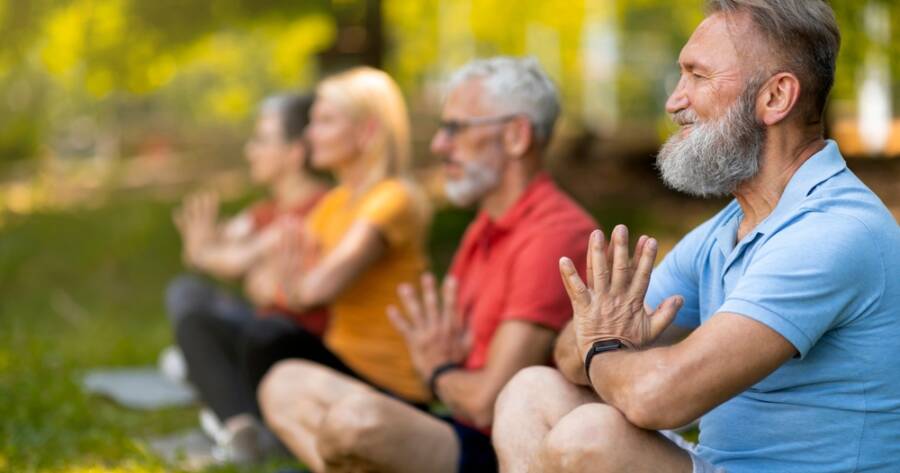Yoga offers seniors a gentle yet effective way to improve strength, balance, and flexibility. With regular practice, it can also reduce stress, ease joint pain, and support better sleep. Tailored to meet individual abilities, yoga provides a safe and uplifting path to enhance both physical health and emotional well-being in the later stages of life.
Benefits of Yoga for Seniors
Yoga provides a wide range of physical and mental benefits that can improve the quality of life for seniors.
- Improved flexibility and mobility: One of the most noticeable benefits of yoga is increased flexibility. As we age, our muscles and joints can become stiff, leading to decreased mobility. Yoga helps to gently stretch and strengthen the muscles, improving flexibility and making everyday movements easier.
- Enhanced balance and stability: Falls are a major concern for seniors, often leading to serious injuries. Yoga poses, particularly those that focus on balance and core strength, can help reduce the risk of falls by enhancing stability and coordination.
- Reduced stress and anxiety: Yoga incorporates deep breathing and mindfulness techniques that promote relaxation and reduce stress. For seniors, who may be dealing with the challenges of aging, yoga can provide a calming routine that alleviates anxiety and improves mental clarity.
- Better sleep quality: Many seniors struggle with sleep disturbances. The relaxation and mindfulness practices of yoga can help improve sleep patterns, leading to better rest and more energy during the day.
- Pain management: Yoga can be particularly beneficial for managing chronic pain conditions common among seniors, such as arthritis or back pain. Gentle stretching and strengthening exercises can help reduce pain and increase overall comfort.
Types of Yoga Suitable for Seniors
Not all yoga styles are the same, and it’s important for seniors to choose a style that matches their fitness level and health needs. Here are some types of yoga that are particularly well-suited for older adults:
Hatha Yoga
Hatha is a gentle form of yoga that focuses on basic poses and breathing exercises. It’s ideal for beginners and seniors looking to ease into yoga without high intensity.
Chair Yoga
For seniors with mobility issues or those who find it difficult to get down on the floor, chair yoga offers a great alternative. This type of yoga adapts traditional poses to be performed while sitting or using a chair for support.
Restorative Yoga
This style focuses on relaxation and is excellent for stress relief. It involves slow, gentle movements and long-held poses supported by props like blankets and cushions, making it accessible for all fitness levels.
Iyengar Yoga
Known for its emphasis on alignment and the use of props, Iyengar yoga is great for seniors as it allows poses to be adapted to suit individual needs and abilities.
Getting Started with Yoga for Seniors
Starting yoga as a senior doesn’t require special skills or equipment. Here are some tips for beginning a yoga practice:
- Consult with a healthcare provider: Before starting any new exercise program, it’s wise to consult with your doctor, especially if you have any existing health conditions or concerns.
- Find the right class or instructor: Look for yoga classes specifically designed for seniors, either at local community centers, gyms, or yoga studios. A qualified instructor experienced in teaching seniors can guide you through poses safely and adapt movements to suit your abilities.
- Start slowly and listen to your body: Yoga is not about pushing yourself to the limit; it’s about finding what feels good for your body. Start with gentle poses and progress at your own pace. It’s important to listen to your body and avoid any poses that cause pain or discomfort.
- Use props and modifications: Don’t hesitate to use props like blocks, straps, or chairs to help support your practice. Modifications are a normal part of yoga and help make poses accessible to everyone, regardless of age or physical condition.
- Practice regularly: Consistency is key in yoga. Even short, daily sessions can have significant benefits over time. Aim for at least 2-3 times a week to start seeing improvements in flexibility, balance, and overall well-being.
Safety Tips for Senior Yoga Practitioners
While yoga is generally safe, seniors should keep a few safety tips in mind:
- Warm up properly: Always start with a gentle warm-up to prepare your muscles and joints for the poses.
- Avoid overstretching: It’s easy to overdo it, especially when trying new poses. Focus on gentle stretching without forcing your body beyond its limits.
- Stay hydrated: Keep a water bottle nearby and take sips throughout your session to stay hydrated.
- Take breaks as needed: Yoga should be a relaxing and enjoyable practice. Take breaks whenever you feel the need, and never feel pressured to keep up with others in a class.
Find Fulfillment With Yoga
Yoga offers seniors a wonderful way to stay active, improve flexibility, and enhance overall well-being. Its adaptability makes it accessible to people of all fitness levels, and the focus on mindfulness and relaxation can have profound benefits for mental health.
By incorporating yoga into your routine, you can enjoy a more balanced and fulfilling lifestyle, no matter your age. Whether you’re looking to reduce pain, increase mobility, or simply find a peaceful way to relax, yoga provides a holistic path to better health for seniors.
